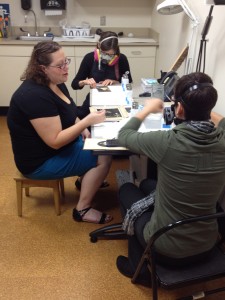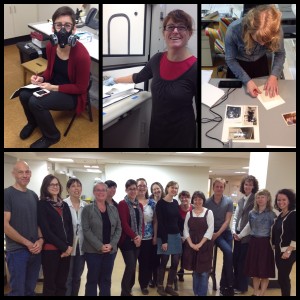
We are all still talking about the shear amount of information we learned last week at “Photo Conservation for Book and Paper Conservators,” taught by Gawain Weaver and Jennifer Olsen of Gawain Weaver Art Conservation.
Colleagues from across the country came to the Verne and Tanya Roberts Conservation lab for this event. We had people from California, Colorado, Iowa, Kansas, New York, Minnesota, and of course several from the Raleigh-Durham-Chapel Hill area (Duke, UNC Chapel Hill and the NC State Archives). Some work in university libraries and archives, others in private practice, and some in other types of organizations. It was a great mix of experiences and perspectives.
This workshop was geared toward mid-career conservators who already have a fundamental understanding of materials and solvents, experience in evaluating the condition of materials, and experience in making treatment decisions. The goal was to give paper and book conservators hands-on experience working with various historic and modern photographic processes and to get us more comfortable in doing so.

Gawain and Jennifer are very generous teachers. They use a good mix of demonstration, hands-on practicums and lectures to get the information across. We were also able to work with samples of actual photographs, which helped move theory into practice. We learned about removing silver mirroring, removing photos stuck to glass, attaching and removing heat set tissue, and various methods of mechanical and chemical surface cleaning. We also discussed disaster recovery, mold removal, humidifying and flattening, housing options, and general mending.

We participated because so much of our photographic collections are valued primarily for their informational content, not their artistic value (although that isn’t always the case). Therefore, they do not rise to the level that would trigger sending them out for treatment. Yet, some of our photos need more treatment than simply housing. I think we all came away with a better understanding of what we can do even though photographs are not are area of expertise.
What I value most about last week is the camaraderie of professionals learning from each other; meeting new colleagues and working with long-time friends; being treated professionally by people outside your specialty; learning skills that would otherwise be difficult to learn; and walking away knowing more about when you should and shouldn’t undertake treatment. I also enjoyed the parts that began with the caveat, “You would never do this with real objects, but watch what happens when you do!”
We have posted images from the workshop on Flickr, and you can see composites and a brief description of Day 1, Day 2, Day 3, and Day 4 on Preservation Underground. Check out Melissa Tedone’s review of the week on Parks Library Preservation.





